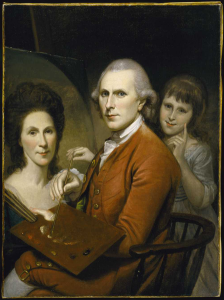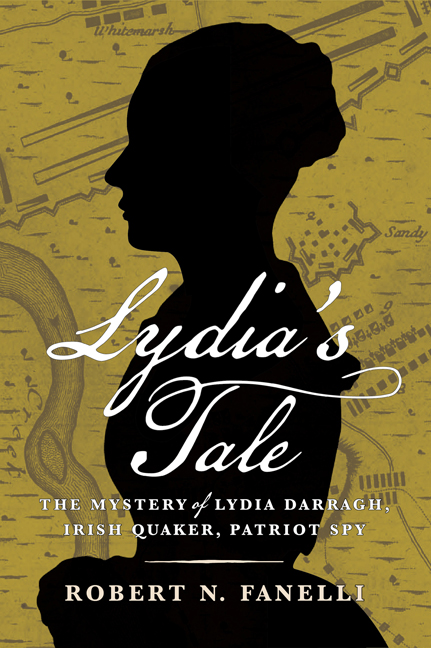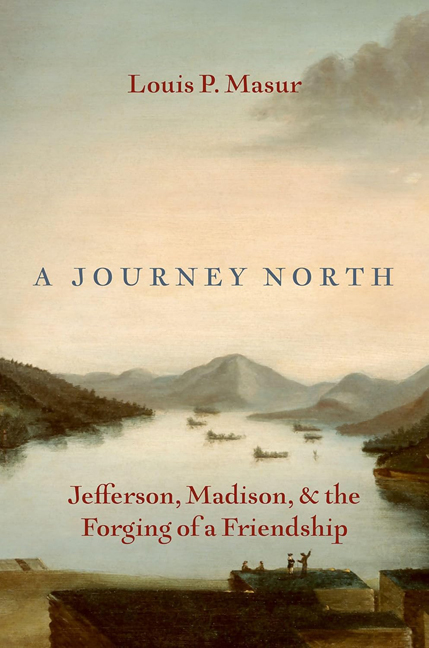
When one thinks of a telescopic sight on a rifle one does not think of the Revolutionary War. However strange, there was one documented rifle with a telescopic sight. It was conceived and test fired by a very improbable rifleman: Charles Willson Peale. Charles Willson Peale (1741-1827) was the most prominent American portrait painter of the period. He is best known for his portraits of George Washington and other Revolutionary leaders. In addition he had mechanical inclinations which included clock repairing. As a strong patriot, he also served in the Philadelphia Associators, a militia unit.
To our delight Peale kept a diary which refers to the experimental weapon. Peale did not work alone, he had a partner in the telescopic sight venture; David Rittenhouse (1732-1796). Rittenhouse was a well known American astronomer. In 1775, The American Philosophical Society petitioned the Pennsylvania legislature to have Rittenhouse appointed as director of an observatory since he could run the operation and could also make all the instruments. He built telescopes, clocks and surveying equipment. In 1780, he was the first to use natural spider webs as reticles in his telescopes rather than the thicker silk threads.
Both Peale and Rittenhouse were members of the American Philosophical Society. In the library of the Society, located in Philadelphia, is a typed copy of Peale’s diary[1]. The entries are brief, and only give us a glimpse of the work in which Peale and Rittenhouse were involved.
The entries of interest to us are:[2]
December 27, 1775, “bought a set of gun mountings 9/.”
January 1, 1776, “attended Mr. Rittenhouse all Day about a Riffle with a Tellescope to it.”
January 2, “Ditto.”
January 3, “Bought a Gun Lock 22/6 I found it faulty & offered the Man 2/6 to take it back but he would not. I bought another at 40/.”
January 5, “a set of Loop to hang up a Gun 6/6, spent in attending & working about my riffle. Threatened to complain to the committee [this would be the Committee of Safety] of Henry ——– who had taken an extortionate price for the Gun Lock on Wednesday last.”
January 6, “attending the man stockg sd. Gun.”
January 8, “still attendg about my Gun.”
January 9, “pd for stockg my riffle 22/6 to Mr. Williss.”
January 10, “Attnd Mr. Palmer & Mr. Rittenhouse about sd G-n.”
January 11, “pd. Mr. Palmer for a Riffle Barrel 3=10.0 Bullit moulds 3/9 a screw wiper [attachment for ramrod to hold cleaning patch] 1/3 – finished the Riffle this morng: Shot her afternoon in the Stadt House [State House] yard, not quite Sighted.
January 12, “put a sight to my Gun.”
January 13, “Paid Joseph (Mr. Rittenhouse’s Journeyman) for makg Box, Loops &c. for my riffle 15/…finish a charger [container to hold a single predetermined measure of powder] to load with, go out with Mr. Rittenhouse to shot, the Brich Box [patch box] opened & I lost all my Bullits & wiper.”
January 16, “Cleaned my Gun, am very Idle”
February 4, “made a shot-Bag.”
February 5, “spent in trying to sight my Riffle.”
February 6, “ditto.”
February 7, “ditto.”
February 8, “ditto.”
February 9, “making piece with springs to prevent the Eye being hurt by the kicking of the Gun.”
February 10, “ditto. in soldering hard solder use chalk to prevent an old place undoing.”
February 11, “ditto.”
February 16, “shoting the Riffle.”
February 19, “shot several times in a small piece of Papier at 100 yds. distance.”
February 27, “shooting with Riffle.”
February 29, “went to see Mr. Rittenhouse who tells me he has often heard Rifflemen say, that when they shot large loads, they could never shoot true, if so, Mr. Rittenhouse accounts for it in the Manner, that the air suddenly pressed together till it will not go closer, the Ball glances off in another direction, as in the instance of Lighting flying so very crucked, which goes strait in a Vacuum.”
March 2, “shot my riffle in the Stadt House yard, left the Barrel & Lock at Mr. Palmer’s.”
The March 2, 1776 entry is the last in reference to the experiments with the rifle.
The brief diary notations are subject to some interpretation. Peale biographer Charles Coleman Sellers states that, “…he made a telescopic sight…” and that “the weapon had also a breach box hollowed in its stock to carry bullets and wiper, a bayonet, worn in a scabbard at the side, and a steel ramrod. The two men tested ammunition and different loadings of powder. Rittenhouse accounted for the inaccuracy of a shot fired with a too heavy charge as due to the compression of air against the bullet.”[3]
A biographer of Rittenhouse, Brooke Hindle, also using these diary entries, wrote that Rittenhouse “worked with Peale on two rifle improvements. One was a telescopic sight, and the other an idea of Peale’s for building into the stock a box large enough to carry bullets and wipers. Rittenhouse set one of his journeymen to work on this invention, and, when it was ready, Peale and Rittenhouse took it out in the fields to test it. Neither inventor was disheartened when the device opened accidentally, spilling all its bullets; neither was at his best in pursuits related to soldiering.”[4]
The same incident is recorded by Dr. Maurice Jeffers Babb as “Charles Willson Peale and he [Rittenhouse] almost put their eyes out experimenting with telescopic sights on rifles. They might have been much more hurt if Peale’s cartridge box had not fallen open and lost him his ammunition on the way to the proving grounds.”[5]
The diary does not provide us with all that we would want obviously. However, some observations and deductions can be made without going too far out on a limb. As Peale spent two entire days (January 1st and 2nd, 1776) consulting with the telescope and instrument maker David Rittenhouse about a telescopic sight it seems reasonable to believe that a great deal of thought went into the project. On January 10, Peale was back in consultation with Rittenhouse and the gunsmith, Mr. Palmer. History was made on the afternoon of January 11, 1776 when Peale shot his new rifle, probably the first ever to have been equipped with a telescopic sight, for the first time “in the Stadt House yard.” The “Stadt House” of course is the State House in Philadelphia; now known as Independence Hall.
The January 13 entry seems to indicate special work was done as Peale paid Rittenhouse’s Journeyman for making “box, loops” which may mean a patch box of some sort and sight rings to attach the telescopic sight to the rifle barrel. The fact that the box opened and the bullets and wiper fell out does not seem significant except in frustration to the shooters.
It is interesting that he spent February 5, 6, 7, and 8 “trying to sight my Riffle.” It is not hard to visualize Peale struggling to make adjustments to the telescopic sight and find the load of powder that would give the best accuracy. Doubtless, there was much trial and error, and frustration involved. On the 9th, Peale works on a spring arrangement for the telescopic sight so it would not impact his eye on firing. This gives us a picture of a telescope with very short eye relief which required the eye to be close, too close, to the end of the scope. Upon recoil the scope would hit Peale in the eye.
On February 16th, he is back firing again and then on the 19th he “shot several times in a small piece of Papier at 100 yds.” Success. He shoots again on the 27th. On the 29th he talks over his load with Rittenhouse, receives an opinion about heavy loads, and shoots the rifle for the last recorded time on March 2.
The flintlock rifle with a telescopic sight was a reality. It may not have been practical but at least it worked to some degree. The “riffle with a tellescope to it” apparently no longer exists. However, perhaps someday, it will be rediscovered. Stranger things have happened.
[1]. Peale, Charles Willson, Typed Diary, pages 14-20, Charles Willson Peale Papers (B/P 31 #2), American Philosophical Society, Philadelphia, PA.
[2]. The diary entries clearly were never meant for publication. They are brief notes to remind Peale of dates events occurred. Most of them refer to his portraits such as, “attended Mr. Bordely this Morng: put a sight to my Gun. Rd. some pictures which Mr. Pace showed to Mr. Hancock Boston Delegate, where I expect business.” References to money are shown as in “2/8” which indicates 2 shillings 8 pence.








10 Comments
Man, I would LOVE to see what that looked like…
So I am assuming it had cross hairs? I wonder.
Twistification –
Whether it had cross hairs or not will never be known for sure but considering that instrument/telescope maker David Rittenhouse (who pioneered the use of spider webs as cross hair material)built the telescope I would think that it had cross hairs of some sort.
Did Mr. Peale in his diary ”The Rifle with a telescope to it ” say he lost a special loading device? It’s been along time since I studied him .If so he may have been shooting conical bullets as a round ball doesn’t need a special loading device to start the bullet straight in the bore .
Mr. Heckathorne – Regrettably, he did not mention a special loading device nor using conical (sugarloaf) bullets. Conicals would not necessarily require a special device to load; for example a Minie ball. So much I wish Peale had mentioned in his diary about this rifle and the scope.
Sure a Minie ball is undersized and fits well in the bore but a tight patched bullet needs a loading tool to keep it from tipping in the bore as on long range rifles popular in the 1830’s and later (see the “Caplock Rifle” ) . The reason I mentioned it as with a round ball will shoot reasonably well at long distances that one could see with the naked eye ,to shoot farther would tend to indicate a scope and conical bullet . Did you receive the picture of the wheelock rifle with optics?
All our questions would be answered if we only had the rifle & scope to inspect. Or, a detailed description from Peale or other keen observer. Those scant references in the diary are the only mention Peale, or anyone else, made re the rifle and the experiments. Since a short starter, false muzzle, conical/sugarloaf bullet, etc. are not mentioned I think it likely they were not used. I think rather we’re talking about a patched roundball and a telescope, likely with crosshairs, attached to the barrel with some sort of adjustment mechanism. Sighting it in must have been difficult. Clearly, it was not a practical weapon in its time. I did receive the photo of the optics (looks much like a magnifying glass) on the wheellock. Interesting but it too likely was not a workable solution to the problem.
Fascinating article. I’m wondering if Peale would have consulted with Ben Franklin. It would seem like a perfect collaboration.
I have a picture of a wheelock with optics on it
Galileo and Isaac Newton were also said to have been trying to develop a telescopic sight for a rifle I found statements to such but no original sources. Just something to think about also the magnifying glass on the wheelock would have been useless without another glass in front of it which if one sees the entire rifle indicates there was another glass can’t prove it but something to research for anyone interested